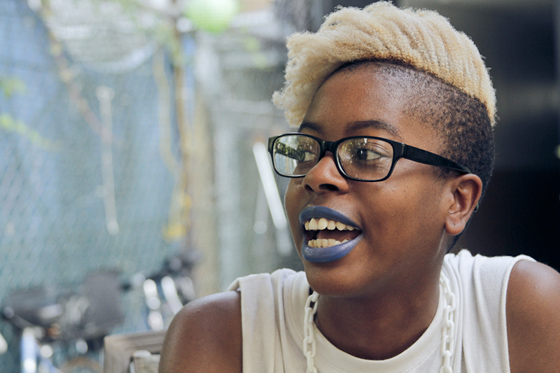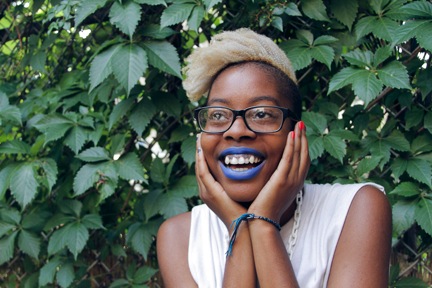Yulan Grant is a video artist based in New York, originally from Kingston, Jamaica. Currently, she is exploring how to use appropriated footage, sound, and literature to discuss issues of class, race, and gender. Additionally, she writes and distributes zines that highlight the work of queer artists of color. As a young, queer woman of color, Yulan’s artistic perspective is one of class-consciousness and community activism. Among her projects is “Database,” an ongoing network that aims to document people of color killed by extrajudicial forces beginning in the year 2012.
Interviewer: Annie Malamet
Photographer: Alison Tyne
A: Tell me about “Database.” What is the aim of that project, and when did you start it?
Y: I started “Database” in the summer of 2012 and it was because this social justice blogger I was following on Tumblr was live reporting the police gunning down one of his neighbors. And I was like whoa, that’s insane, you know because you never hear of these stories ever. And even to this day there hasn’t been a news article covering this person’s death. So that was my main impetus to start “Database” because obviously People of Color (POC) are killed all the time and you never know. The Trayvon Martin was an example of a case where it was actually documented and people got a chance to put it into the public spotlight. But you know even then, something like that case that was well known as the Trayvon case, the verdict still showed you world we lived in. He wasn’t the first and he obviously won’t be the last. Every 36 hours a POC is gunned down by extrajudicial forces, whether that be the police or people who think they are. So my goal for “Database” is to try and track these deaths as best as I can. It’s user based, so people send me emails and links to verify. But it’s unfortunate because a lot of the time, there is no write up of these stories. So people will tell me “oh this person was killed.” But if I can’t find a write-up on it, I can’t verify the information, so I can’t document it because I can’t spread false information.
Unfortunately its really sad because it’s a project that can never be completed. That’s really depressing. Do it bums me out. I actually had to stop for a while. A few months ago I just stopped updating for a few weeks. Every weekend, to go through and list the 4 people that have been killed in the past 2 weeks…it was such a mental toll that I couldn’t do it anymore. Something like this doesn’t exist. But lately the Malcolm X grassroots movement has started a list as well, so traction is finally gaining so people can know these things are happening. I just wanted to create a visual map that people can track and see that this is something that is really happening.
One story that really got to me was this dad in California who was picking up his 2 kids from school and the police thought he was kidnapping his daughters and ended up killing him in his car in front of his children.
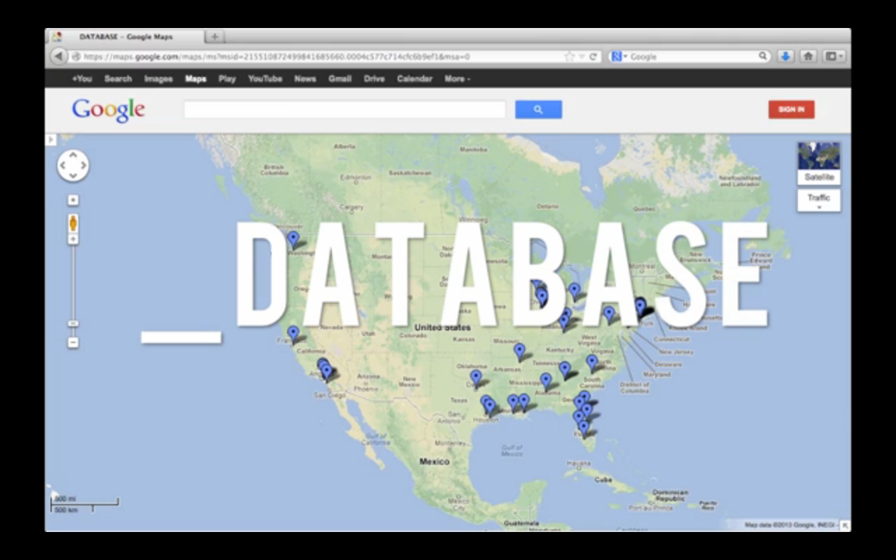
A: That makes me ill.
Y: It’s fucking crazy. There was this one case in Alabama where this guy who was mentally ill, and a lot of the time these people are, and he was going to the police department to pay a fine for something, and he got upset and something set him off but he didn’t attack anyone. But the police tasered him, and hogtied him to the back of the car, and tasered him to death. And nothing happened to these people. Then you have something like Ramarley Graham which happened in the Bronx where there is actual CCTV footage of the cops breaking into his grandmother’s house and killing him in his own bathroom. And those cops were acquitted a few months ago. They had paid leave to even add to that bullshit. Its very disheartening, it’s a depressing project to pick up.
A: I can imagine why you would need a break from that.
Y: Yes its very depressing.
A: Yeah that sounds like it could take a huge toll on you.
Y: Oh my god. Yeah but, it’s really interesting to see the community outreach just saying, these are the stories I know of personally.
A: So it’s clearly a politically motivated information vehicle. But the video you created is very artful and powerful. Do you see “Database” as an art piece or as purely a vehicle for information, or is it both?
Y: I think it is both. I mean, it’s problematic of me to say it’s both actually, but it is. It being an art piece could make it exploitative because I’m making art about these people’s suffering, but at the same time I’m trying to chronicle it. I don’t feel like I’m servicing the community, that I’m the best thing that ever happened to them. It’s exploitative because it’s dredging up very hurtful things and all these families are still suffering and will continue to suffer. But by making the video in conjunction with “Database,” I felt like it made it a bit more powerful because I could employ sound and image. The whole thing is based in Google maps so I knew I would use Google Maps in the video. I just wanted to the video to show how someone could interact with the piece. And then for the video I chose two people and it was Ramarley Graham who is from the Bronx, so in the piece you see the street view of his hometown and it chronicled his walk home from school, and it ends at his house, and the overlay of the CCTV footage of the cops breaking into his home, and then you hear audio of the mother of Kimani Gray from that protest in Flatbush, which was crazy because that protest showed people really taking it the streets, which was awesome. And in the video it’s his mother, and I remember I was at this protest, and it was crazy because she was just screaming “Stop killing our kids!”
A: Yeah I remember that from the video.
Y: That shit got me, it was so insane. She’s Jamaican, and the entire neighborhood is just poor Caribbean people, whether its Afro-Caribbean or Latin-Caribbean, and I really identify with that way too much, and the hurt in her voice was insane. Right off the bat, when everyone was peacefully organizing, the media started calling it “riots” like “Oh the Brooklyn Riots are happening.” And I’m like, this is not a riot, 10 black people are assembling that is NOT a riot. When there is a riot you’ll KNOW there is a fucking riot believe me, cause you’ll see my ass there.
A: (laughing)
Y: When there’s a riot you’ll SEE ME, people are just hanging out right now trust me. It was really crazy. And you know with Trayvon, it’s just the most well known case right now. And in the video there’s the walk through the gated community where he was killed. And then protest footage from people that gathered in Union Square when the trial was taking place.
A: I notice that lot of your pieces exist online. Do you find the Internet to be a more democratic way to distribute work and therefore more in line with your artistic message, or is just a matter of convenience?
Y: Its mostly convenience and it’s an easy way to distribute things. That’s the thing with art, practicing it and studying it, its very classist and elitist. I could have a bomb ass idea I want to execute, which is why I keep notebooks full of ideas, but if I don’t have the resources to do it what happens then? And that’s the case with most things I want to create. By making it exist online, it reaches such a broader community. Even though I do plan on showing “Database” in a gallery, its still like…I could show this to 30 people who will see this, but what does that do really, you know? Like it’s nice that they are seeing it and liking it, but these are people that don’t reflect the socio-economic background.
A: Of the people you’re talking about.
Y: Exactly. So it’s nice that you like it, and its great and awesome and you should participate in it because this is the reality for a lot of people. But when you exit this space you’ll probably forget about it. I’m well aware of that, I’m the same way, I have ADD I’m not going to remember some art piece I saw in a gallery. So by it being online, you can get the widest demographic.
A: Yeah and when its online people who the piece actually reflects can access it.
Y: Yeah. I’m not anti-gallery in any sense.
A: What do you feel are the core problems with the gallery setting? Is it too academic?
Y: It’s academic and the people who I would want to see it, not that I have a core audience, but like my mom is not going to go the Pace Gallery to see it and probably never will. Jay-Z might!
A: (laughing)
Y: You know he’s chilling with Marina (Abramovic) and that’s the bomb, that’s cool as shit, but you know my mom isn’t going to be doing shit like that and seeing things that reflect her life and her socio-economic background. But you know I’d never be in the Pace Gallery. If it’s a small art space in Bushwick, yeah. Bushwick is still in the process of being gentrified but its still a mostly Hispanic neighborhood. But the art spaces aren’t in those places (where those families live). So the people who are harassed by the police, the ones who are actually living that life, are not going to be seeing the piece if its just in some gallery in Bushwick. Art has this history of being owned by straight white men and that’s still very much the case.
A: Totally. “Database” is bringing awareness, but at the same time, POC are already very aware of this reality.
Y: Exactly. POC are very aware. The Zimmerman trial was everyone being like –
A: I wish I were surprised.
Y: Yeah my mom said to me, “This is why Johnny should have never died” in reference to Johnny Cochran like yeah that’s true, but this whole trial was like a dull aching pain because we knew what the outcome would be. But shout out to Obama for having that press conference this morning. That was really good.
A: I didn’t see it.
Y: Yeah it was really good because he should be discussing this. And you have people on twitter saying like “Obama is a racist, we call it the White House for a reason!” And I’m like…you guys are still saying this? It’s not even clever anymore. My favorite “I’m not a racist BUT Obama shouldn’t be talking about this.”
A: “I’m not a racist, but I’m about to say something really racist.”
Y: That’s right. Ok, like this is the most personal he’s been in a long time. I’ve been beefing with Obama for the past couple of months so its like, ok you go you should be talking about this.
A: Yeah its pretty great that he even addressed it at all. It’s not his domain but it should be.
Y: Yeah like I’m glad they are trying to see if they can retry him (Zimmerman) in federal court. That would be amazing. Is it going to happen? Probably not. But the fact that they’re even acknowledging that its messed up is really important.
A: At the same time, as your piece shows, there’s so many more incidents.
Y: So many more. It’s a small drop in a big bucket.
A: Why do you think this case in particular got so much attention?
Y: That’s a really good question. People picked up on it quickly and it was well documented and then the whole Florida “stand your ground law.” And also that Zimmerman wasn’t a police officer, he was a wannabe cop. And the NAACP was on it. But most of the cases it’s the police doing these things and we all know the police can do anything they please. And you had Trayvon, a kid in his own neighborhood, he had skittles, he wasn’t some hoodlum even though he had his hoodie up. And then Giraldo Rivera, I’ll never forget he was like “Oh he shouldn’t have been wearing his hoodie.” Like Giraldo look at you. You are not in a position to judge ANYBODY. You’re a fool. You can’t do this right now. There’s nothing worse than a wolf in sheep’s clothing. Like him and Clarence Thomas, all of them, I’m done.
A: Do you think the case got more attention because Zimmerman is Latino?
Y: Yeah it dual for him because you have his name, and he is Hispanic but is white-passing. It was interesting because they brought his mom on the stand and were like “LOOK! Color can be racist!”
A: well to shift gears, I really like your “REdact” piece.
Y: Oh cool thank you, I forgot I did that.
A: I really like the idea of incorporating literature into visual art because I’m a big book person. Why did you choose “The Bluest Eye” for that?
Y: Well first of all I love Toni Morrison. I think she is-
A: A goddess.
Y: Yes a goddess, she’s bomb as hell. She’s beautiful. She’s the black woman I want to be when I’m 65, just spouting wisdom. She’s an idol. I first read “The Bluest Eye” in high school in my English AP class. I was one of 2 black people in my class and my teacher was pretty racist. That was the first time I was immersed in Toni Morrison not just from a hobby standpoint but an academic one. I mean the story is fucking crazy.
A: Yeah its one of my favorites.
Y: Its so good, and so fucking real. And I think of my grandmother because she has blue eyes. Its just one of those amazing books that confronts race, gender, class, sexuality in such a beautiful way. Her prose is magical. Whatever she writes touches me on so many levels. So “The Bluest Eye” has always been one of those books for me that just really stood out. You can pick any line from the book and it’s saying something, so that’s why I chose it. I think it came out well.
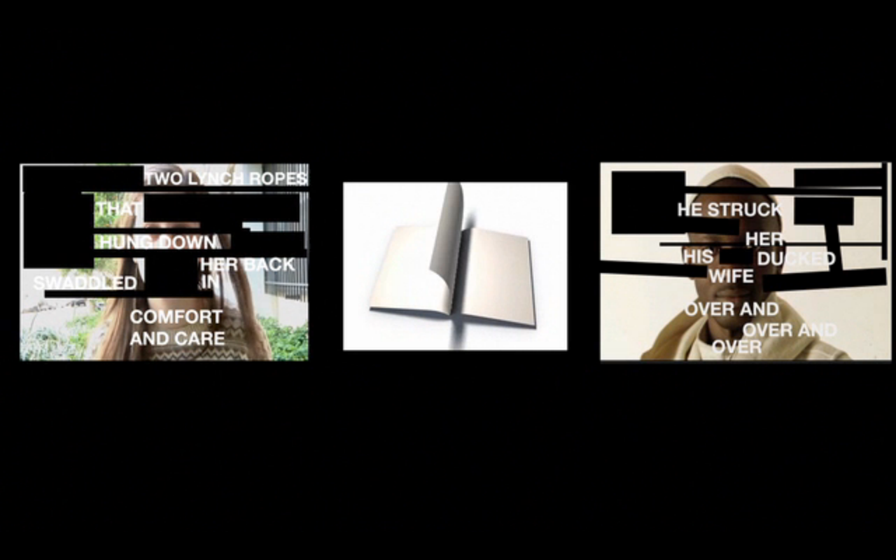
A: Did you use direct excerpts or were you collaging sentences?
Y: I’d pick a sentence, one or two, and then I would black out some of the words, so yes it’s a collage. I remember one of the quotes was some long sentence talking about domestic abuse how this man is beating her, and then she’s falling in love with him, so I tried to take out some of the words so that it shows the never-ending cycle of domestic abuse. I remember the first time I read that book I cried. I needed extra time to read it because I was like, really going through it while I was reading it.
A: I notice a lot of the excerpts you choose are really sexual. Why is that?
Y: I don’t know maybe I was just really horny when I made it.
(Both laughing)
A: That’s fair.
Y: It was finals so I was stressed out and probably just really horny.
A: Where do you think the history of black literature and art fit into your general artistic thought process?
Y: Well books were my first love. I wanted to be a writer when I was younger, but that didn’t work. I realized that I don’t have the patience and the actual love for it to do it. But I was always surrounded by books, I was that weird 3 year old reading the encyclopedia because I didn’t want to go outside. Also, to transition from Jamaica to America where much of Jamaican literature is oral, that’s how we pass things down. Then coming here where it’s a long history of written literature, and using that as a way to further assimilate myself into black culture. Because even though I am black, I’m not African American so I’ve always been seen as an outsider of some sort. So literature was my way of coping and learning more about the black experience through a different lens.
A: Cool! So in “Apocalypse Medley,” you describe that video as a “meditation on appropriation and mortality.” Can you explain that for me? Because I watched it and was cracking up…
Y: (laughing)
A: And I don’t know if that’s because I know you, or what.
Y: Yeah that’s funny because people were like “Are you being serious with this?” Well I was thinking about the project for a long time, I sketched it out so I knew exactly what I wanted to do. And also, how do I phrase this. So for 2 years I’ve been working with this director Leilah Weinraub, who is making a film about this black lesbian strip club in LA. So she would do these video pieces for Ghetto Gothic, which is this warehouse party thrown in Brooklyn, so I was being really thrown into that club lifestyle and I would help her with those videos. She said essentially that there’s enough content in the world right now where there’s no real need to create new things. And that’s true, especially with YouTube and even just stock Getty images, there’s so many stock videos of everything. The artist who did The Clock (Christian Marclay), he would go through movies and TV shows and find the passing time on the clock within the footage. So I was like, yeah that’s true, I don’t need to create something new. So it being a mediation on appropriation and mortality…is that what I said?
A: Yeah (laughing)
Y: (laughing) ok. That sounds REALLY fancy, that shit sounds bomb. But yeah you know the whole fucking Mayan calendar bullshit.
A: OH ok.
Y: Yeah that’s when I released it so I was like, ok whatever we’re all gonna die. Anyway, Gospel Medley (which is in the video) was one of my favorite songs by Destiny’s Child when I was growing up. We’d always have power outages in Jamaica so me and my sisters, to occupy time we would sing that song. And it works perfectly because…well I’m going to miscount them. There’s 4 of them. Yeah I always forget Kelly. I’m sorry Kelly.
A: Poor Kelly.
Y: Yeah but there was 4 of us, so we could choose what harmony we were going to sing, and we’d practice it all the time even though we have horrible voices. But that song came out right after Y2K and my family was convinced we were all going to die. So my family was like “it’s the end!” And I was like…I’m 10 years old. I can’t die right now, I just started living! I just learned out to walk. We rung in midnight at church on doomsday.
A: And this was in Jamaica?
Y: Yeah this was in Jamaica. My parents are crazy.
A: That’s really good.
Y: (laughing) yeah but to this day its one of my favorite songs. And it reminds me of church and I’m really into church as an outsider who was kind of raised within the church but not really because my family is lazy. But it was like me coming to terms with pop culture and religion at the same time. I think the apocalypse is really interesting. I hope it doesn’t happen; I’m not that morbid. It was a fun thing to do.
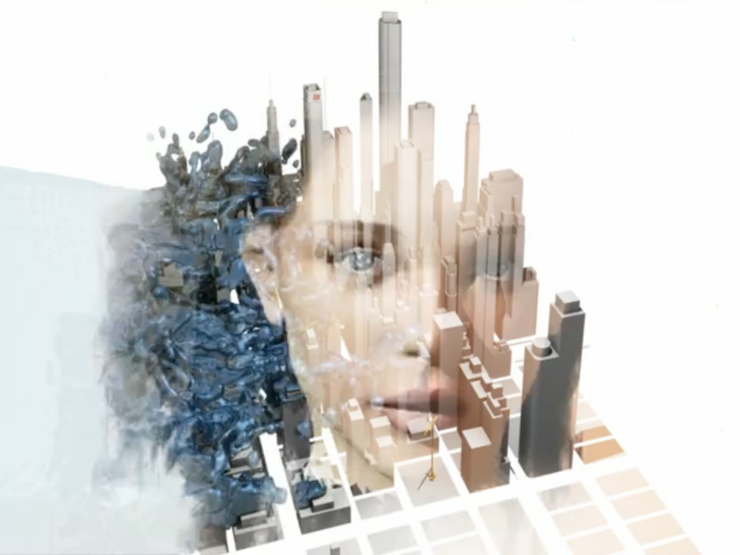
A: Its really funny.
Y: Its funny. People laughed about it.
A: I really like it.
Y: But then they read the statement and were like, whoa is this real? This is some serious shit. Like, oh wow were you were Foucault when you made this video?
A: (laughing) Ok. So can you tell me about “Bad Grammar?”
Y: “Bad Grammar” is a zine/collective that me and two of my friends, Justin Allen and Branden Owen, started.
A: So what is the theme of the zine?
Y: Well the name “Bad Grammar” is playing off the inaccurate assumption of inarticulateness in the black community. We know how to speak.
A: (laughing)
Y: We speak English REAL good. We’re trying to have a platform for queer artists of color. It’s interesting because I was talking about it, and some random dude bumped into my conversation and was like “you’re already part of the gay community why do you need to further ex yourself out?” And like, this is why.
A: Yeah because of YOU.
Y: You’re a shining example actually, in case you were wondering (laughing). But it’s been great so far we’ve had a good reception. For the first issue we chose the House of LaDosha.
A: I love the House of LaDosha.
Y: (points to her shirt) Repping the fam right now. It originally started because we were supposed to do a zine that correlated with Superchief gallery. But things didn’t work out that way which I’m glad it didn’t, retrospectively because now we can expand. Originally we started off with “Baby Hair” and the curator (of Superchief) got in touch with us and asked us to make zines for their gallery, so from there we’ve expanded and just been doing our thing. So House of LaDosha had their show there, “The Whole House Eats.” So we had a visual and oral history of how everyone in the house got together and formed this amazing collective. We also did Cakes Da Killa, Keem Smith, and Jay Lamar. And in the new issue we’re releasing we did J Boogie. Its really awesome people have been really receptive. I’m actually meeting with Printed Matter after this because they want to carry “Baby Hair,” but they don’t care about “Bad Grammar” (laughs) its fine like we don’t have enough money in our budget to print copies for them to sell because we sell it through BGSQD, which is the only remaining gay bookstore in New York City.
A: I know that zine making is something you’ve been involved with in the past. What do you feel is the place is the place of the printed zine in a culture where everything exists electronically?
Y: I love to touch and feel and collect and hoard so maybe that’s why. Also, at least with me, I have a busted Android I’m not that in with technology I don’t have a Kindle or an iPad or anything like that. But other than that, seeing something printed on high gloss paper, and just hearing the pages curl and to see and touch and feel it, I think it’s so good. I guess print is dead, but you don’t want to be reading off a computer all the time. It’s nice to have something on your shelf. Something to give a guest to read.
A: What are your plans for the future? I know you’ve been involved in some fashion projects in the past, is that world you’re still interested in being a part of?
Y: Yeah actually I was supposed to work as a taste maker for something…but that didn’t work out because I’m working for Afropunk instead.
A: Cool!
Y: Yeah its awesome but I have to go into work at 10am now, which is not awesome.
A: (laughing)
Y: But yeah I’m still interested in fashion. Hopefully, “Bad Grammar” is going to start making shirts as well. Plans for the future? Don’t go too broke.
To see Yulan’s work, visit www.yulangrant.tumblr.com

